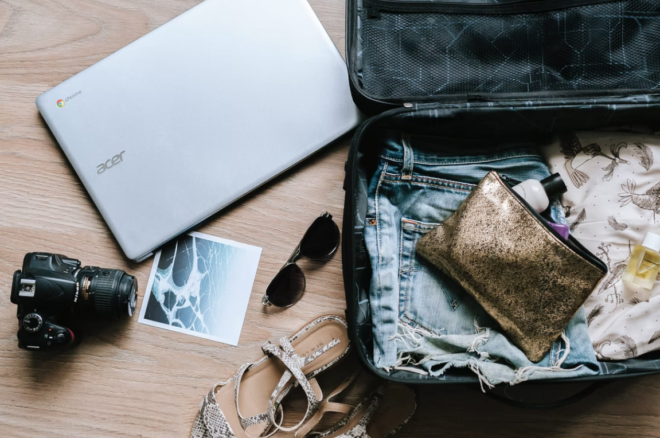You put a lot of effort into creating a more eco-friendly lifestyle at home. But the moment you need to venture out for a vacation or take a work trip, those efforts can easily fall to the wayside. But if you stay prepared and pack appropriately, you can be an eco-warrior on the road and in the skies, too. Here is how to pack your suitcase more consciously, from choosing a compostable phone case to prevent your iPhone from becoming e-waste to packing reef-friendly sunscreens.
Use Tech to Your Advantage But Reduce E-Waste
When it comes to packing a suitcase more consciously on your travels, tech devices can come in handy. For example, storing offline digital maps on the phone can replace a heavy travel guide. However, one worry is that your devices can become easily broken, shattered or cracked during your travels. So, it’s essential to try to reduce your e-waste, too. But just how can you do that?
Easy! By protecting your electronic devices properly. Whether you use comfortable, eco-friendly Apple Watch bands or keep your Apple earbuds from collecting dirt with AirPods cases, you can preserve your tech and keep it from dents, dings and splashes.
Pack Minimally
Another way you can pack your suitcase more consciously is by reducing how many clothes you bring. Face it: There’s always a pair of shoes or a cute top you insisted on bringing, only to wind up wrinkled and unused at the bottom of the bag. Instead of overpacking for your trip, think more minimally and bring only what you absolutely need.

By packing only the necessities, it also lightens your load. And lightening your load can ultimately reduce your carbon footprint, both by air travel and vehicle transportation. Yes, your suitcase’s weight does have consequences. Think about it: You already know that the more loaded your car is, the more it affects the gas mileage. The same holds true with an aircraft’s weight, burning more fuel the heavier it gets. According to Climate Change and Energy Solutions, if passengers simply choose to remove one pair of shoes, a plane’s fuel savings would equal 10,500 cars off the road each year.
So aim for less clothing, shoes, etc. Bring along versatile and transitional garments and accessories — leggings, jeans and neutral-colored tops and sweaters — instead of something special for every occasion, day and night. Try to contain it in only one carry-on size piece of luggage to reduce your emissions and an extra backpack or tote for reading material, snacks and your reusables (more on that later).
In short, think of your suitcase as a super tiny capsule wardrobe. Take only what you need to get by and nothing more.
Fill Your Suitcase with Sustainable Clothes
Not only should your clothes make up a stylish capsule wardrobe, but each garment should be made sustainably. But what exactly makes a sustainable piece of clothing? Upcycled apparel and even textiles made from renewable, sustainable materials like bamboo or hemp are all great options. If you choose cotton, reach for organic styles. Cotton is more harmful than you realize. According to the WWF, producing one cotton shirt or pair of jeans takes over 20,000 liters or 5,283 gallons of water.
Also, make sure to avoid fast fashion. While it’s tempting to go shopping for the latest, trendiest clothes for your vacation, be more mindful of the garments you buy. Choose items that can be rotated in your wardrobe for a long time. The fashion industry is solely responsible for eight to 10 percent of global carbon emissions, not to mention fast fashion supports inequality in developing nations. So it’s time to nip it in the bud and cut down on how much we shop for clothes.
Pack the Reusables
Traveling away from home means you’re met with an onslaught of single-use plastics. It’s tough to escape from the miniature hotel shampoo bottles to the plastic water bottles and cups served during flights. So do your part and prepare with your arsenal of reusables.
What kind of reusables? Glad you asked! Here’s a quick list:
- Water container — Did you realize our society is still consuming and going through one million plastic bottles a minute? It’s ridiculous if you ask us. So do your part and fill up a reusable water bottle at a water fountain to avoid needing a plastic water bottle.
- Metal or Silicone Straw — Ditch the plastic straw and bring your own. Choose one that slips into its own container or cloth wrap so it doesn’t pick up any dirt or grime in your suitcase or luggage.
- Utensils and Food Containers — Along with a reusable straw, be sure to pack some utensils, too. Don’t forget the aluminum bento box or glass container to pack up those leftovers, too.
- Toiletries — Don’t basically bring your own mini hotel bottles. Instead, opt for plastic-free toiletries like shampoo bars. If you need to bring beauty products, pack reusable makeup remover pads or refillable containers for lotions.
- Tote Bag — A tote bag will help you say “no thanks” to those plastic bags at the market or a souvenir shop, obviously.
If you’re flying, be sure to pack reusables in your carry-on luggage, purse or backpack, too. This way, you’re prepared for those in-flight drinks and meals.
Choose an Ocean-Friendly Sunscreen
Sometimes, it’s not about what you pack, but what you don’t pack. While you can’t wait to get the sun-kissed glow on vacation, be mindful of what kind of sunscreen you bring to your next destination. Sunscreen is quite harmful to the environment and especially our oceans and waterways. Lathering up with sunscreen made with oxybenzone and octinoxate is doing no favors to the gorgeous underwater reefs you’re snorkeling or diving to see. In fact, the Coral Reef Alliance states that these chemicals are partly to blame for coral bleaching.
Reef-safe sunscreens can be found. However, one way to eliminate or reduce your dependence on sunscreen is to wear other protective layers such as a long-sleeved rash guard and a broad-brimmed hat. In areas where you need to wear sunscreen, reach for more natural mineral-based options such as zinc oxide or titanium oxide.




